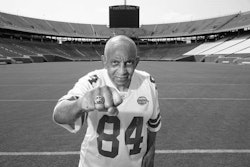College football is arguably the most popular sport at the nation’s colleges and universities. Bringing in more than $90 million annually in revenue at the highest grossing University of Texas, it is no wonder that school leaders view the football team as less of an extracurricular activity and more of a moneymaker. The revenue that is generated by college football programs only represents a small piece of the overall financial benefits. Schools with strong athletic programs, particularly in the area of football, bring in more prospective students and have larger booster groups in place.
Like every area of higher education, finding the right blend of diversity on the football field is a challenge. Take Charlie Strong, for example. The coach of Louisville that led the team to victory in the Sugar Bowl was an assistant for a whopping 27 years before finally being given a head coaching opportunity. In just two seasons, he produced a bowl-worthy squad and began receiving offers from other schools, like Tennessee. Strong insists that he will not leave Louisville because of his loyalty to his superiors but is there more to it than that?
The Facts
Not many African-American head coaches at the college level have had the same success as Strong—mainly because many have not been given the chance. Of the 124 Division 1-A college football schools, only 15 had African-American coaches in the 2012 season, according to an executive report by the Black Coaches Association. The Big Ten conference has seen zero Black head coaches in the past 10 years.
While head coaches are the most visible, support positions are severely underrepresented as well. Only 312 of 1,018 of college football assistant coaches are Black, and only 31 of 255 of offensive and defensive coordinators are African-American. Combined, Black football coaches and support staff represent a measly 5 percent of Football Bowl Subdivision numbers.
At Division II and Division III schools, diversity is even worse. The Black Coaches Association reports that, in the 2012 season, only nine schools of 113 in these two categories had head coaches of color. These numbers exclude historically Black universities.
The Problem
Despite the thousands of Black college football players in recent decades, barely a handful has been trusted with leading teams. These ex-players obviously understand the game and know what college athletes face on the field—so what gives?
Part of the problem is that schools are quick to dismiss coaches of all backgrounds when immediate improvement does not take place. The most recent high-profile example was the firing of Jon Embree by the University of Colorado in November. Floyd Keith of the Black Coaches Association called the firing a “disappointment” and wished that the school had given Embree a third season to prove himself. The school pointed to a 4-21 record over the course of two seasons as the reason for the firing, but critics, like Keith, say that just two years is simply not enough time to turn a team around.
Many critics are also quick to point out that White coaches with bad numbers are often still considered a hot commodity by other schools when they are on the market, whereas Black coaches have historically been given just one shot to prove their talent.
It is also important to note that a college football coach does not have the same responsibilities as an NFL one. Winning is valuable to the university, but so are other aspects like graduation rates of players and team conduct. Both play an indirect role in the revenue the school is able to generate in future years by attracting new students. Yet with turnover rates of all college coaches rising every football season, a shift toward a “winning takes place on the field” mentality is evident.
Solutions
The statistics are indisputable when it comes to underrepresentation of African-Americans in all levels of college football coaching. With so much being said about this issue, not much in the way of problem solving has arisen.
Colleges and universities would do well to take a cue from the NFL when it comes to hiring minority coaches. Established in 2003, the Rooney Rule requires NFL teams to interview at least one minority candidate for all vacant head coaching positions and other executive football operation spots. After just three seasons, the Rooney Rule led to an increase of 22 percent in the number of African-American head coaches in the NFL, and those numbers rise every season. A similar rule only makes sense in a college athletic setting, especially since so many other aspects of higher education use affirmative action programs to bolster diversity and opportunity.
Another possible option is for schools to set up coaching mentorship programs for minority players that show leadership potential. An even better approach would be an NCAA-sanctioned program that seeks talented players and gives them some exposure to coaching and maybe even a certificate program. These earmarked players could then begin working their way through the coaching ranks sooner and have a common knowledge base.
All changes need to be initiated by the NCAA, college athletics governing body. For a real dynamic shift to be felt across the board, every school needs to have the same diversity opportunities and rules as all the others. It is not enough to wish that more schools took a closer look at African-Americans to fill head football coaching spots; an overarching game plan needs to be in place for true change to occur.















